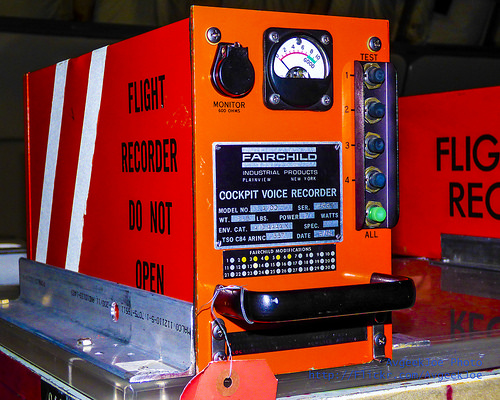Black box flight recorders are a great help for determining the cause of an accident.
- Black box flight recorders are devices located in aircraft to record data in case of an accident, and are made to survive at least 1000°C (1832°F) and a g-force of 3400.
- ‘Black box flight recorders’ are also known as ‘black boxes’ and ‘flight recorders’, usually refers to two separate containers; one a ‘flight data recorder’ or FDR, and the other, a ‘cockpit voice recorder’ or CVD, although sometimes they are held in the same sealed container.
- It is not known for certain why black box flight recorders are referred to as ‘black boxes’, as they are generally coloured in special bright orange or yellow reflective paint, so that they are more visible in search situations, and they are usually labelled with a warning: ‘FLIGHT RECORDER DO NOT OPEN’ in English and French.
- Two of the first innovators of black box flight recorders were François Hussenot and Paul Beaudouin of France, in 1939, and their recorders used a photographic film process.
- Black box flight recorders have the function of recording aircraft performance, voice and audio signals, and sometimes visual footage, although this is not common.
CVD Flight Recorder
Image courtesy of Joe Kunzler/Flickr
- The first black box flight recorders to include both flight data recorders and cockpit voice recorders were invented in the 1950s, in Melbourne by Australian David Warren, a chemist, and a prototype was completed in 1958.
- Black box flight recorders were originally included in the front of an aircraft, but later placed near the tail, as they are more likely to survive damage in that section of the plane.
- Black box flight recorders include an underwater locator beacon (ULB) that is automatically activated in water and sends an ultrasonic signal, known as a ‘ping’, that can be transmitted from up to 6,000 metres (20,000 feet) under water, for approximately 30 days – the duration of its battery life.
- In 1960, black box flight recorders were required to be on all commercial planes in Australia, the first country in the world to have such a law, and these laws now extend to most aircraft in the world that can carry at least 20 passengers.
- It is suggested that black box flight recorders may become obsolete, as live streaming of information from aircraft via satellites to a base station would provide a much easier means of retrieving the information in a crash situation, and this technology is already used on some aircraft.
Bibliography:
Flight Recorder, 2014, Wikipedia, http://en.wikipedia.org/wiki/Flight_recorder
What is a Black Box?, 2014, National Geographic Channel, http://natgeotv.com/uk/air-crash-investigation/black-box







